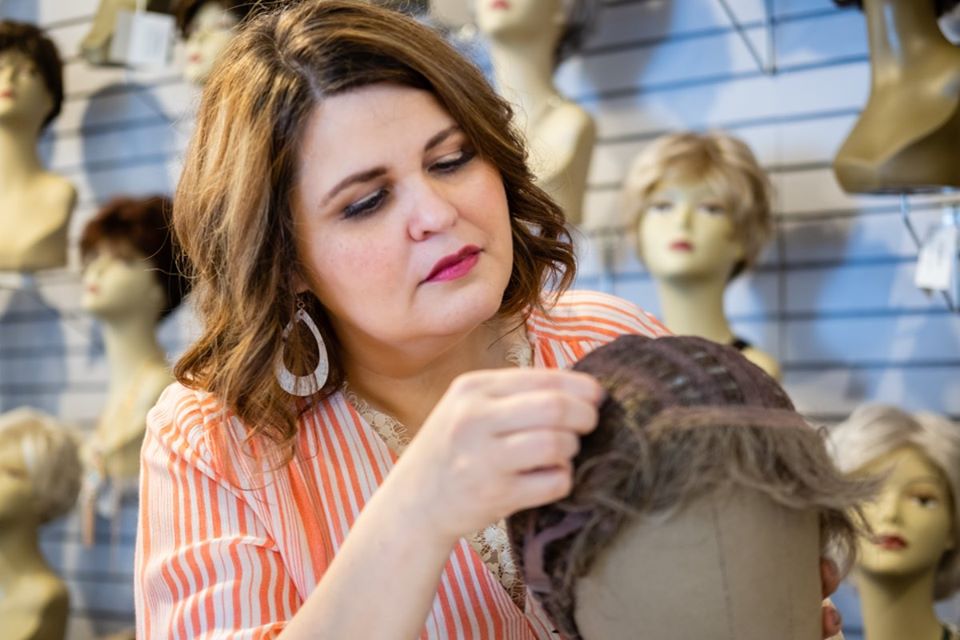Wig Slipping - A Common Concern
Is Your Wig Slipping?
Whether worn for fun and fashion or for hair loss, wigs are a fantastic way to switch up your hairstyle without committing to a permanent change. However, if you’ve ever worn a wig, you might be familiar with the frustrating experience of it riding up or sliding out of place. Fear not, as we delve into the reasons behind this common wig woe and explore effective ways to keep your wig securely in place.
Why Is My Wig Slipping?
The most common concerns we hear about wig slipping are riding up in the back, or moving back away from the hairline – or sometimes both.
We will discuss both of these concerns, first by addressing the common reasons for wigs riding up or slipping back, then providing quick and easy solutions!
Is it in the Right Place?

As simple as it may sound – the first thing to check if your wig is slipping is – am I wearing the wig correctly? Here’s some things to check:
- When putting your wig on, make sure the front of the wig is low enough. It should sit at or just below your natural hairline. If you place the wig too far back on your head, it will slide back.
- Check your ear tabs. They should sit in front of your ears at the temple. Gently press them into the contours of the temples. This helps grip the wig your head and stay in place.
3. Understand where the back of your wig belongs. A common misunderstanding among new wig wearers is that the back of the wig should sit down on your nape. This is incorrect. The back of the wig is designed to sit right under your occipital lobe – the point where the base of your head meets your neck. Often when a client says their wig is riding up, it is because they are pulling it down too far on their nape, which stretches the cap. The wig is naturally moving back to it’s correct position.
Size Does Matter
If you’ve checked that your wig is on correctly yet it still rides up, especially if it rides up in the front and back, it may be the wrong size, or be adjusted to be too small.
If your wig just slides around on your head and does not feel secure, it may be too big.
What can you do? First, when shopping for a wig, have your head professionally measured, so that you can be sure you are purchasing the correct size. At A Special Place, we do not just measure the circumference…we also take a front to back and ear to ear measurement.

Most wigs come with adjustable straps. They may be velcro, hook and eye or pully straps – try adjusting them tighter or looser to see if it affects the fit. If that doesn’t help, schedule an appointment to see about having your wig professionally altered.
Why? Our heads are three dimensional, and while wigs are designed to fit a head with “typical” proportions, heads come in all shapes and sizes. Think about a dress made in a specific size – it is made to specific measurements for the bust, waist and hips. But what if your bust and waist fit one size but your hips another? You may have to size up for the bigger measurments and have the wig tailored to fit the others. The same is true of wigs. You may have to have your wig altered for a perfect fit.
Shape Matters Too

Heads don’t just come in different sizes – they also come in different shapes. A wider or flatter forehead may cause a wig to slide back. A flat occipital bone may not allow your wig to grip the back of your head as it should causing it to ride up.
If your head shape is causing your wig to move around, an alteration may help. Or you may have to use add some security using clips or tape.
Building a Foundation
The fit of your wig is also affected by what’s underneath. Do you have a full head of hair? Just a little peach fuzz? Prepping your scalp and bio hair is essential to securing your wig.
If you have hair – especially if your bio hair is thick or long – you must secure it properly. If you just put your hair in a bun or ponytail, it will create a bump at the back of your head that pull the wig back. Try to make your hair as flat as possible using a wig cap or bobby pins.

If you have very fine, smooth hair, it can create a “slip and slide” for your wig. You can use a fishnet wig cap or a wig grip to create some “traction” for the wig to grip to. Alternatively, you use a gel or mousse to make your hair less slippery.
If you have no hair. Wigs usually grip better to a bald scalp. You may or may not need a wig cap. if your wig still feels like it’s moving, and you’ve already checked that the size is right – it’s probably more of a head shape issue. Try wig tape or a grip band.
Using the Right Products
Ideally, a wig would stay in place without any additional products…but in the real world, sometimes your wig needs a little help.
The good news is, there is no shortage of products designed to give you the security you’re looking for.
- Clips and Combs
If you have hair, one of the easiest fixes is securing the wig to your bio hair. You can do this with bobby pins…or you can sew clips or combs into your wig.
Small clips, sometimes called toupee clips, are ideal for fine, thin hair. Larger combs are better for thick or textured hair.
If you have trouble with traditional clips, there are various types of clips designed for all types of hair.
- Tape and Adhesive
If you have no hair, toupee tape or glue can work wonders! Use a little in the front or back of your wig as needed.
There are various types of adhesive. Daily wear tapes are designed last 12-48 hours and come off easily when you’re ready to remove them.
Longer wear adhesives can secure a wig for 1-6 weeks. Only use longer wear adhesives with human hair wigs, as it is not advisable to sleep in synthetic wigs. These types of adhesives need to be removed with a remover, and is best done by a professional
Theatrical adhesive (such as It Stays) is water soluble and can be worn even if you have hair.
Adhesive works best if your wig has a polyurethaned strip to adhere to. If your wig does not have this, you can have one sewn in.
- Gels and Mousse
Certain hair care products can have an adhesive effect. A popular product – Got2B Glued – is availabe as a spray or a gel. Apply around the hair line and your wig will temporarily adhere to it. Like “It Stays” it is easily removed with water, so it works for individuals with or without hair.
- Caps and Bands
There are a variety of caps and bands designed to keep your wig in place.
A fishnet cap can provide just the right amount of grip to kepp your wig from sliding on slippery hair.
Silicone wig grips work well with or without bio hair. They provide excellent grip. Some people find the bands too tight (while others love the snug fit). You can also sew silicone strips into your wig so you don’t have to wear the band.
Velvet bands. Velvet bands work best if you have some bio hair. The nap of the fabric provides resistance to wig slippage. Most are adjustable for a comfortable fit.
No More Wig Slipping - Keep Your Wig Secure and Comfortable
Wig slippage is a common concern, but armed with the right knowledge and techniques, you can enjoy a secure and comfortable fit. Remember to choose the correct size, prepare a smooth foundation, use wig caps, adjust straps, secure with clips and combs, place the wig correctly, and invest in a quality product. With these tips, you’ll be flaunting your fabulous wig confidently and without any worries of it riding up or sliding out of place.






